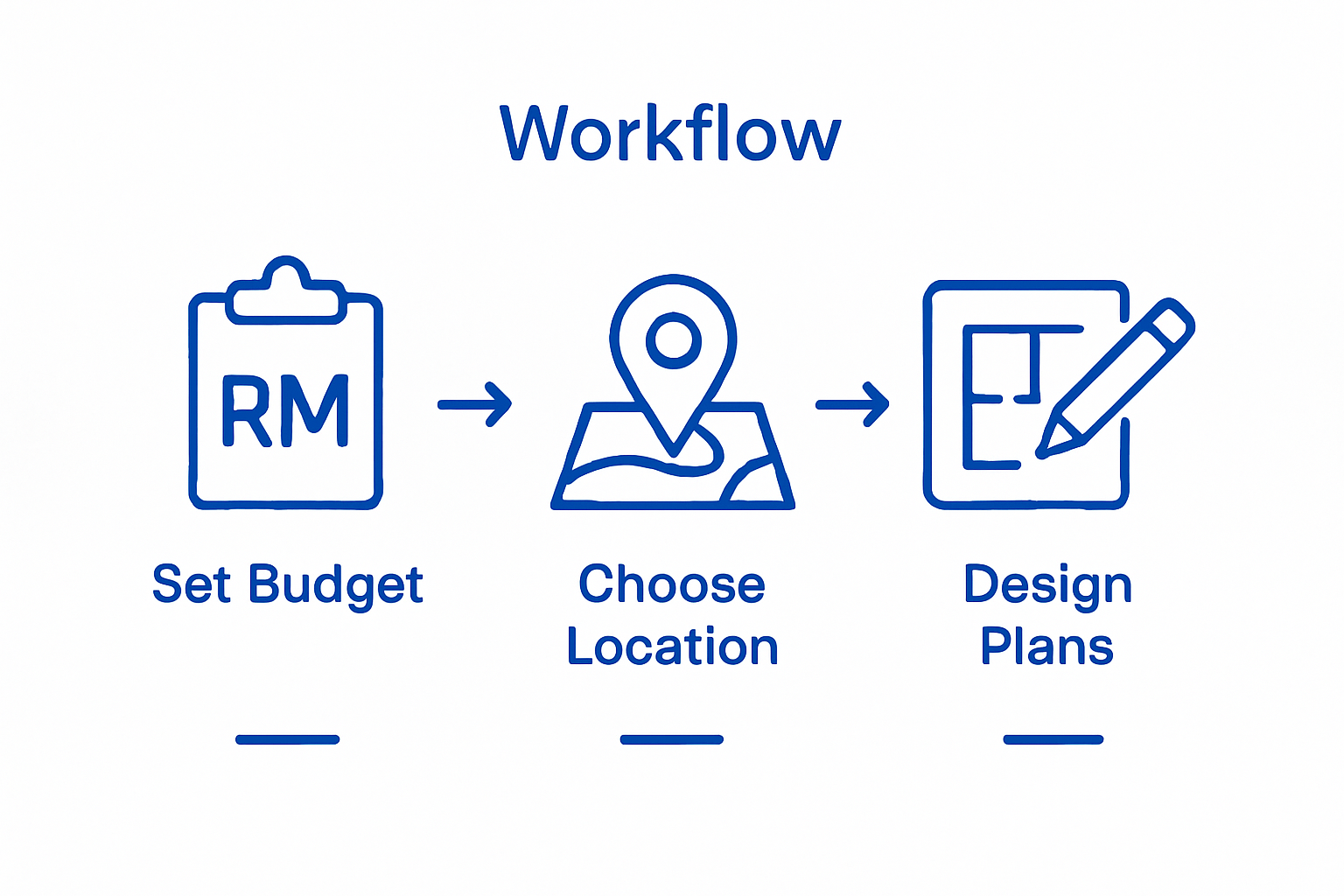
Blog
How to Build a House: Your Step-by-Step Guide to Success | RumahHQ

Building a house in Malaysia has become a major financial milestone for thousands of families every year and the average construction requires a minimum 10-20 percent down payment, making upfront planning more important than ever. Most expect the hard part is choosing tiles and paint colours. The real challenge, though, lies in getting your budget and permits right before you even set foot on your land.
Table of Contents
Quick Summary
| Key Point | Explanation |
|---|---|
| 1. Define Your Budget First | Assess your financial situation thoroughly before starting the construction process to ensure affordability and realistic planning. |
| 2. Choose an Optimal Location | Conduct detailed land research and understand local regulations to enhance property value and ensure construction feasibility. |
| 3. Hire Qualified Contractors | Vet contractors and suppliers carefully to guarantee quality workmanship and materials that meet project specifications. |
| 4. Oversee Construction Vigilantly | Regularly inspect the construction process to ensure compliance with plans and address any potential issues promptly. |
| 5. Conduct a Thorough Final Inspection | Engage professionals for a comprehensive final inspection to ensure compliance with regulations and identify any defects before moving in. |
Step 1: Define Your Budget and Financing Options
Building a house represents one of the most significant financial investments you will undertake. Before breaking ground, understanding your financial landscape becomes crucial to transforming your dream home from concept to reality. This initial step involves comprehensive financial planning that determines not just what you can afford, but how strategically you can structure your home construction project.
Your budget will serve as the foundational blueprint for every subsequent decision in the home building process.
 Begin by conducting a thorough assessment of your current financial situation, including your total savings, annual income, existing debts, and credit score. Lenders will scrutinise these factors when considering construction loan applications, so presenting a clear and stable financial profile is paramount.
Begin by conducting a thorough assessment of your current financial situation, including your total savings, annual income, existing debts, and credit score. Lenders will scrutinise these factors when considering construction loan applications, so presenting a clear and stable financial profile is paramount.
In Malaysia, several financing pathways exist for potential homebuilders. Government schemes like LPPSA financing options can provide critical support for those looking to construct their first home. Typically, these programmes offer more favourable interest rates and more flexible terms compared to traditional bank loans. Consider exploring options through institutions like Bank Simpanan Nasional, Employees Provident Fund (KWSP), and specific government housing initiatives.
Practically speaking, most construction loans will require a minimum 10-20% down payment based on your total project cost. This means if your anticipated home construction budget is RM500,000, you should have between RM50,000 to RM100,000 readily available. Additionally, factor in extra funds for unexpected expenses, which can range from 10-15% above your initial budget estimate.
To verify you are financially prepared, complete these key checks:
- Confirm your total available savings
- Obtain a current credit report
- Calculate your debt-to-income ratio
- Gather all necessary financial documentation
- Schedule preliminary meetings with potential lenders
Remember that transparency and meticulous financial planning will significantly smooth your home construction journey. By establishing a solid financial foundation now, you are setting the stage for a successful and stress-free building experience.
Step 2: Choose Your Location and Obtain Necessary Permits
Selecting the perfect location for your home is far more complex than simply finding a picturesque plot of land. This critical step involves strategic decision making that impacts not just your immediate living experience, but long term property value and potential resale opportunities. Your location choice will determine everything from construction feasibility to future lifestyle quality.
Begin by conducting comprehensive land research in your preferred regions. In Malaysia, areas like Selangor and Kuala Lumpur offer diverse terrain and zoning options. When evaluating potential sites, consider critical factors such as soil composition, drainage capabilities, accessibility to public infrastructure, proximity to essential services, and potential environmental restrictions. Geotechnical surveys become paramount to understanding ground stability and potential construction challenges.
Navigating the permit landscape requires meticulous attention to detail. Local authorities like Pihak Berkuasa Tempatan (PBT) will require detailed documentation including land ownership certificates, site plans, architectural drawings, and environmental impact assessments. Building your dream home on your own land involves understanding specific municipal regulations that vary significantly between different administrative districts.
To successfully navigate permit acquisition, prepare the following documentation:
- Original land title documents
- Detailed site survey reports
- Comprehensive architectural plans
- Environmental compliance certificates
- Proof of professional architectural and engineering registrations
Budget additional time and resources for potential bureaucratic delays. Permit processing can take anywhere from three to six months, depending on local government efficiency and the complexity of your proposed construction. Professional consultants who understand local regulatory landscapes can significantly streamline this process, reducing potential administrative bottlenecks and ensuring smoother progression towards your home building journey.
Verify your location and permit readiness by confirming you have obtained all necessary approvals, understand local building codes, and have a clear timeline for subsequent construction phases. Your thorough preparation during this stage will prevent costly delays and complications in later stages of home construction.
Step 3: Design Your House and Create Detailed Plans
Designing your house represents the transformative moment where abstract dreams crystallise into tangible architectural blueprints. This crucial step bridges your vision with practical engineering requirements, translating personal preferences into structurally sound and aesthetically pleasing living spaces. Your design must harmonise functionality, comfort, and individual lifestyle needs while adhering to local building regulations and structural integrity standards.
Commence your design journey by developing a comprehensive brief that captures your household’s unique requirements. Consider factors such as family size, daily routines, future adaptability, and specific spatial needs. Architectural design is not merely about aesthetics but creating living environments that evolve with your life stages. Professional architects can help translate these nuanced requirements into precise architectural drawings that balance personal vision with technical feasibility.
Visualising your dream home through 3D plans becomes an invaluable tool in this process. Modern design technologies allow you to walk through virtual representations of your future home, enabling precise adjustments before actual construction begins. These digital models help identify potential spatial challenges, test different layout configurations, and make informed design decisions that minimise costly modifications during the building phase.
Engaging professional design consultants becomes critical in transforming conceptual ideas into executable plans. These experts understand complex building codes, structural engineering principles, and can anticipate potential construction challenges. They will prepare detailed technical drawings including floor plans, electrical layouts, plumbing schematics, and structural specifications that serve as precise instructions for your construction team.
To verify your design readiness, confirm you have:
- Comprehensive architectural drawings with precise measurements
- Detailed material specifications
- Structural engineering reports
- Complete electrical and plumbing layout plans
- Municipal approval stamps on design documents
Remember that exceptional home design transcends mere visual appeal. It represents a holistic approach to creating living spaces that reflect your personality, accommodate your practical needs, and provide long term comfort and functionality. Your meticulously crafted design will serve as the blueprint for transforming your dream home from concept to reality.
Step 4: Hire Contractors and Buy Materials
Hiring the right contractors and sourcing quality materials represent the foundational pillars that transform architectural designs into physical structures. This critical stage demands meticulous research, strategic decision making, and a keen understanding of construction industry dynamics in Malaysia. Your selection process will directly influence the quality, durability, and overall success of your home building project.
Begin by conducting comprehensive background checks on potential contractors. Professional credentials matter significantly. Seek contractors registered with professional bodies like the Pertubuhan Arkitek Malaysia (PAM) or the Master Builders Association Malaysia (MBAM). Request comprehensive portfolios demonstrating previous projects similar to your proposed construction, verifying their expertise in residential building techniques specific to Malaysian architectural and environmental conditions.
Building your dream home without financial strain requires strategic material procurement. Local suppliers in regions like Selangor and Kuala Lumpur offer diverse material options, but prioritise quality over immediate cost savings. Engage multiple suppliers, compare quotations, and negotiate bulk purchase discounts. Understanding material specifications becomes crucial ensuring structural integrity and long term performance of your home.
When interviewing potential contractors, develop a structured evaluation framework. Request detailed project proposals including comprehensive cost breakdowns, estimated timelines, material specifications, and warranty provisions. Transparent communication prevents potential misunderstandings. Ensure all agreements are documented in legally binding contracts that clearly outline scope of work, payment schedules, performance expectations, and dispute resolution mechanisms.
To verify contractor and material readiness, confirm you have:
- Verified contractor professional registrations
- Comprehensive written contracts with clear deliverables
- Detailed material specification documents
- Proof of contractor’s previous successful project completions
- Comparative quotes from multiple material suppliers
Remember that successful home construction is a collaborative journey. Your careful contractor selection and strategic material procurement will lay the groundwork for transforming architectural blueprints into your dream living space. Patience, thorough research, and clear communication are your most valuable tools in this critical phase of home building.

Step 5: Oversee Construction and Ensure Quality Control
Construction oversight represents the most critical phase where your architectural vision transforms into physical reality. This stage demands vigilant monitoring, strategic intervention, and a comprehensive understanding of construction processes. Your active involvement determines the quality and precision of the final outcome, making consistent site supervision an absolute necessity.
Establish a systematic approach to site monitoring by developing a structured inspection schedule. Schedule regular site visits, ideally weekly, to track progress, validate workmanship, and address potential issues before they escalate. Regular site visits are crucial to ensuring your home meets exact specifications, allowing you to maintain alignment between original design intentions and actual implementation.
Quality control extends beyond visual inspections. Develop a comprehensive checklist covering critical construction stages including foundation laying, structural framing, electrical and plumbing installations, and finishing work. Each phase requires meticulous verification against original architectural plans and Malaysian building standards. Professional contractors should provide detailed progress reports, but your personal oversight adds an additional layer of accountability.
Understand that effective communication with your construction team forms the backbone of successful project management. Maintain open, respectful dialogue, documenting all discussions and decisions. Potential discrepancies or modifications must be formally recorded and mutually agreed upon. This approach prevents misunderstandings and creates a transparent workflow that protects both your interests and the contractor’s professional responsibilities.
To verify construction quality and progress, confirm you have:
- Comprehensive photographic documentation of each construction stage
- Detailed written progress reports from contractors
- Signed verification documents for completed construction phases
- Independent structural engineering assessments
- Compliance certificates for electrical, plumbing, and structural work
Remember that construction oversight is not about micromanagement but strategic guidance. Your informed, consistent engagement ensures that each construction stage meets the highest standards of quality, safety, and architectural integrity. Patience, attention to detail, and proactive communication will transform your architectural vision into a meticulously crafted living space.
Step 6: Conduct Final Inspection and Move In
The final inspection represents the culmination of your extensive home building journey, transforming years of planning and months of construction into a tangible living space. This critical stage serves as the ultimate validation of your investment, requiring meticulous attention to detail and a systematic approach to ensuring every aspect of your new home meets predetermined quality standards.
Professional final inspections are not optional but mandatory, representing your ultimate quality assurance mechanism. Engage independent structural engineers and certified building inspectors who can provide unbiased assessments of your completed property. These professionals will comprehensively evaluate structural integrity, electrical systems, plumbing installations, and overall compliance with Malaysian building regulations. Their detailed reports serve as crucial documentation for future maintenance, potential insurance claims, and long term property valuation.
Understanding the intricacies of final home inspections becomes paramount in this phase. Conduct a thorough walkthrough with your primary contractor, systematically documenting any minor defects, unfinished details, or areas requiring remedial work. Pay particular attention to potential structural settling, paint finishes, joint alignments, and functional testing of electrical and plumbing systems. Your keen eye can identify nuanced imperfections that automated inspections might overlook.
Prepare a comprehensive moveIn strategy that extends beyond physical relocation. This involves coordinating utility connections, updating residential addresses, transferring essential services, and obtaining necessary occupancy permits from local municipal authorities. Consider creating a staged moveIn plan that allows gradual transition and systematic setup of different living spaces, minimising potential disruptions and allowing methodical arrangement of your new home.
To verify final inspection readiness, confirm you have:
- Comprehensive professional inspection reports
- Signed completion certificates from contractors
- All municipal occupancy permits
- Detailed property handover documentation
- Comprehensive photographic evidence of final state
Remember that moving into your newly constructed home represents more than a physical transition.
Below is a checklist table summarising the key verification steps required in each main stage of the house-building process, ensuring nothing essential is overlooked.
| Stage | Checklist Item | Purpose/Outcome |
|---|---|---|
| Budget and Financing | Confirm total available savings | Ensure you have sufficient starting funds |
| Obtain current credit report | Establish eligibility for loans | |
| Location and Permits | Secure all necessary land and permit approvals | Avoid legal or regulatory issues |
| Design and Planning | Approve comprehensive architectural and engineering plans | Guarantee technical and regulatory compliance |
| Contractors and Materials | Verify contractor registrations and sign contracts | Ensure quality and legal protection |
| Construction Oversight | Collect photographic documentation and written reports | Track progress and quality at each phase |
| Final Inspection and Move In | Receive professional inspection reports and occupancy permits | Prove home is safe and ready for occupation |
Ready to Make Your Dream Home a Reality?
After reading this step-by-step guide, you now understand just how detailed and challenging building a house in Malaysia can be. From strict budgeting and permit requirements to choosing the right contractors and managing ongoing site checks, the risk of costly mistakes or delays is always looming. Many homeowners struggle with unclear quotations, difficult permit processes, and uncertainty about which professionals to trust. If you feel overwhelmed at any step, you are not alone—constructing your perfect home is a complex journey that demands clarity, reliability and expert support.

Let RumahHQ remove uncertainty from your house-building journey. We offer free design consultations, fixed-price packages, and end-to-end support that covers everything from planning approvals and budgeting to reliable project management. Our solutions are tailored for those building in Selangor and Kuala Lumpur, and we specialise in helping you secure flexible financial options such as LPPSA and KWSP. Start with a clear, professional quotation and enjoy the confidence of quality guarantees as well as structure warranties. Discover how RumahHQ simplifies every stage, from initial dream to final move-in. Take the first step towards your stress-free home construction by visiting our main site today and claim your complimentary consultation. Your dream home is closer than you think.
Frequently Asked Questions
What should I consider when defining my budget for building a house?
When defining your budget, assess your total savings, annual income, existing debts, and credit score. Ensure you account for a down payment of 10-20% and allocate extra funds for unexpected expenses to establish a solid financial foundation for your home construction.
What documents are required for obtaining building permits?
You will need the original land title documents, detailed site survey reports, comprehensive architectural plans, environmental compliance certificates, and proof of professional architectural and engineering registrations to successfully obtain building permits from local authorities.
How can I ensure the quality of construction during the building phase?
To ensure quality construction, establish a systematic approach to site monitoring by scheduling regular inspections, developing a comprehensive checklist for critical construction stages, and maintaining open communication with your construction team to document any discrepancies or modifications.
What should I look for during the final inspection of my new home?
During the final inspection, engage independent structural engineers and certified building inspectors to evaluate the property’s structural integrity, electrical systems, and plumbing installations. Conduct a thorough walkthrough to document any defects or unfinished details, ensuring your new home meets predetermined quality standards.
Recommended
Source link
kontraktor rumah
bina rumah
pinjaman lppsa
pengeluaran kwsp
spesifikasi rumah
rumah batu-bata
pelan rumah
rekabentuk rumah
bina rumah atas tanah sendiri
kontraktor rumah selangor
rumah banglo



